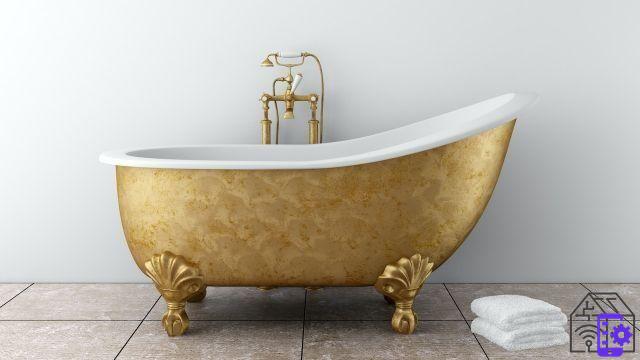
Who knows how many of you own it, and how many have wondered how the bathtub has changed throughout history.
Perhaps not many know that it is an ancient object, and that all things considered it has spanned the centuries, modifying its essential components very little. Moreover, in recent times, with the boom in wellness and an ever-increasing attention to the care of one's psychophysical well-being, the bathtub is making a comeback.
Before discovering how the bathtub has changed, it is necessary to give a concise definition.
What is the bathtub
As we have seen several times in this section, the simple definition of an object or tool already outlines its characteristics and use to perfection.
The bathtub is a container to be filled with water to immerse oneself and take a bath. Definition that already tells us two things: it is called "bathroom" because it takes a bath and not because it has to be in the room commonly called the bathroom. And in fact more and more modern bathtubs, so-called design, are showing off in open spaces or perhaps in the garden.
Another thing: since the bathtub is a vessel to be filled for immersion, its shape has necessarily changed very little, from almost four thousand years ago to today.

How the bathtub has changed: the oldest testimony
If it is difficult to accurately date the birth of the bathtub, we know that already four thousand years before Christ the Egyptians paid great attention to hygiene rules.
There were strict rules for the burial of the dead, prescriptions for nutrition, social relations and sexual intercourse. And the homes of the wealthiest had a bathroom.
Although it was the slaves' task to pour the water as a shower, the first bathtubs date back to that time.
To discover the very first one that has come down to us, however, it is necessary to move to Greece, to the island of Crete, and precisely to the Palace of Knossos. One was found there basin that dates back to around 1700 BC, and which for the time showed great attention to detail and an advanced water system.
The bathtub in Greco-Roman antiquity
In ancient Greece the bathtub, made of stone or metal, was used both in private homes and in public bathrooms. The young athletes, with a practice still in use today, filled it with cold water and plunged into it after training, to tone the muscles.
In the third century BC the bathtub arrives in Rome and begins to be thought of as a modern object.
Meanwhile, various models are produced, with different shapes and widths. In addition, the tub begins to be conceived as an instrument of relaxation: therefore, the use of oils, essences and perfumes is started to make the most of the stay in the water.
How the bathtub has changed: the Hammam
To know how the bathtub has changed, you need to move not only in time but also in space.
The concept of well-being linked to immersion in the tub has its origins in Arab culture, where the bathroom immediately acquires two other values: the curative and the social one. The Hammam, or Turkish bath, was born in Syria in the eighth century BC
How the bathtub has changed: domestic use
Bathtubs have remained virtually identical for centuries. It should be noted only the (unfortunate) debut of wooden tubs, during the Middle Ages, understandably with little success.
If throughout the nineteenth century bathtubs were present only in stately homes, with the entry of drinking water into the houses, the bathtubs enter the houses.
E the materials change: zinc, enamelled cast iron and marble are flanked by porcelain and ceramic, and more recently by polymethylmethacrylate (a plastic material).

The tub
A revolution in bathtubs was introduced in 1968 by Roy Jacuzzi. Who invents none other than the whirlpool, even if the bathtubs equipped with this function are often still today called with the inventor's surname: Jacuzzi.
However, these are also the years in which the tub becomes a status symbol, a privilege of a few returns. Meanwhile, the increasingly hectic life is pushing more and more families towards the cheaper, faster and less cumbersome shower.
Discount The magnificent Spilsbury or the murders of the ...
The magnificent Spilsbury or the murders of the ...
- Robins, Jane (Author)
Today: the return of the bathtub
To understand how the bathtub has changed in recent years, we must remember what was said at the beginning of the article. And that is that the growing focus on self-care is making the tub come back. Also because today there are increasingly sophisticated modelsi: with adjustable headrests, built-in radio, chromotherapy and operated by voice commands. If the bathtub is to be the symbol of comfort, then it is to the end!
And with the return to the relaxed times of a soak in the bathtub, classic forms are back too: for example, today the Victorian-inspired freestanding bathtub is in great demand, which unlike the built-in ones can be placed anywhere, including the outdoor spaces of the house.




















![[Review] Samsung Powerbot VR7000: the robot vacuum cleaner from Star Wars](/images/posts/6bc44de38605b5c0fa12661febb1f8af-0.jpg)





